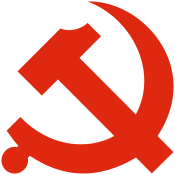More languages
More actions
"CPC" redirects here. For other uses, see CPC (disambiguation).
Communist Party of China 中国共产党 | |
|---|---|
 | |
| Abbreviation | CPC |
| General Secretary | Xi Jinping |
| Founders | Chen Duxiu Li Dazhao 1st National Congress |
| Founded | 23 July 1921 |
| Newspaper | People's Daily |
| Think tank | Central Policy Research Office |
| Youth wing | Communist Youth League of China Young Pioneers of China |
| Membership (2022) | 96,710,000 |
| Political orientation | Marxism–Leninism Mao Zedong Thought Deng Xiaoping Theory Three Represents Scientific Outlook on Development Xi Jinping Thought |
| Website | |
| http://cpc.people.com.cn/ | |
| Part of a series on |
| Communist parties |
|---|
The Communist Party of China (CPC) is the vanguard of both of the Chinese working class and of the Chinese nation. It is guided by its ideology which is a practical application of Marxism-Leninism to the specific conditions of China. Among these ideological developments is Socialism with Chinese characteristics which emphasizes the development of China's advanced productive forces, the orientation of China's advanced culture and the fundamental interests of the overwhelming majority of the Chinese people. The realization of communism is the highest ideal and ultimate goal of the Party. [1]
History
Founding
The Communist Party of China was founded on July 23, 1921, heavily influenced by the events of the May Fourth Movement and the October Revolution.[2] At its first congress, the party only had about 50 members.[3] Although the party was founded on July 23, its anniversary is officially celebrated on July 1. Owing to the shortage of archival materials available at the time, which indicated that the party was founded in July 1921 but did not provide an exact date, in June 1941 the Central Committee of the Communist Party of China declared July 1 to be the anniversary of the party's birth. Although historians were later able to determine the exact date to be July 23, the anniversary is still celebrated on July 1.[4]
Civil war and War of Resistance against Japanese Aggression
In 1934, the Chinese Red Army began the Long March and retreated from Jiangxi to Shaanxi to avoid persecution from the Kuomintang and established a revolutionary base in Yan'an.[5]
After fascist Japan invaded China, the Chinese Red Army became part of the Eighth Route Army.
After many years of civil war in which the CPC achieved total victory in mainland China and most of the coastal islands, led the People's Liberation Army to defeat the National Revolutionary Army of the Republic of China, and forced the Republic of China into a military coup.
First Generation
The government of the Republic of China retreated to Taiwan. Mao Zedong established the People's Republic of China in Beijing in 1949, the only ruling party in the PRC leading the Workers' and Peasants' Alliance and the United Front on behalf of the working class and exercising the People's Democratic Dictatorship in mainland China since October 1949.
Second Generation
In 1978, the third plenary session of the CPC Central Committee approved Deng Xiaoping's reform and opening up policy and established several special economic zones.[3]
Fifth Generation
By 2021, the CPC had reached over 90 million members.[3]
Demographics
In 2020, the Communist Party of China had 91,914,000 members, about 6.57% of the population of China. In 2017, about 26.7% of members were women.[6] In 2015, roughly 30% were farmers, herdsmen or fishermen, 25% were white collar workers, 18% were retirees, and 8% were government employees.[7]
On July 2, 2001, Jiang Zemin allowed the possibility of membership to be extended to billionaires (Not technically bourgeoisie, as land ownership is illegal in China)[8] Though despite this, the politburo and central committee are barred to these billionaires. The National People's Congress and Chinese People's Political Consultative Conference also includes parties that aren't the CPC. 2,980 seats are available in the National People's Congress, only 45 are held by the capitalist class. The Chinese People's Political Consultative Conference includes the regions of Hong Kong and Macau, religious bodies and non-CPC members. Only 59 and 2,200 available seats are held by the capitalist class.[9]
Controversies
Disputed English nomenclature
The CPC is incorrectly referred to as "Chinese Communist Party" (CCP) in Western media, despite the CPC declaring "Communist Party of China" to be the official English translation of its native name.
Structure
CPC members are recursively grouped into party branches; higher-level party branches regulates lower-level branches.[10] When a branch exceeds a manageable size; it gets managed by a higher-level branch of the parent branch.
For example, party (or grassroots) branches with between 50 and 100 members are grouped into General Party Branches. General Party Branches regulate grassroots branches.
References
- ↑ The constitution of the Communist Party of China
- ↑ Hu Qiaomu (1953). Thirty years of the Communist Party of China. Beijing: Foreign Languages Press.
- ↑ 3.0 3.1 3.2 "Reflections on the Communist Party of China’s Centenary" (2021-07-08). Qiao Collective. Archived from the original on 2022-07-18. Retrieved 2022-09-11.
- ↑ "共产主义小组的建立与中国共产党的成立" (2004-10-25). Xinhua News Agency. Archived from the original.
- ↑ "A preview of key moments in CPC's history" (2021-07-01). CGTN. Archived from the original on 2021-10-17. Retrieved 2022-10-16.
- ↑ https://news.sina.com.cn/c/2018-06-30/doc-ihespqrx6865303.shtml
- ↑ https://daily.jstor.org/communist-party-of-china/
- ↑ https://www.washingtonpost.com/archive/politics/2001/07/02/china-allows-its-capitalists-to-join-party/98c51d3e-590c-4f1b-a52a-132b3def1281/
- ↑ Class Analysis of the CPC in 2019- MpBritt
- ↑ China Global Television Network. "Who Runs the CPC"
